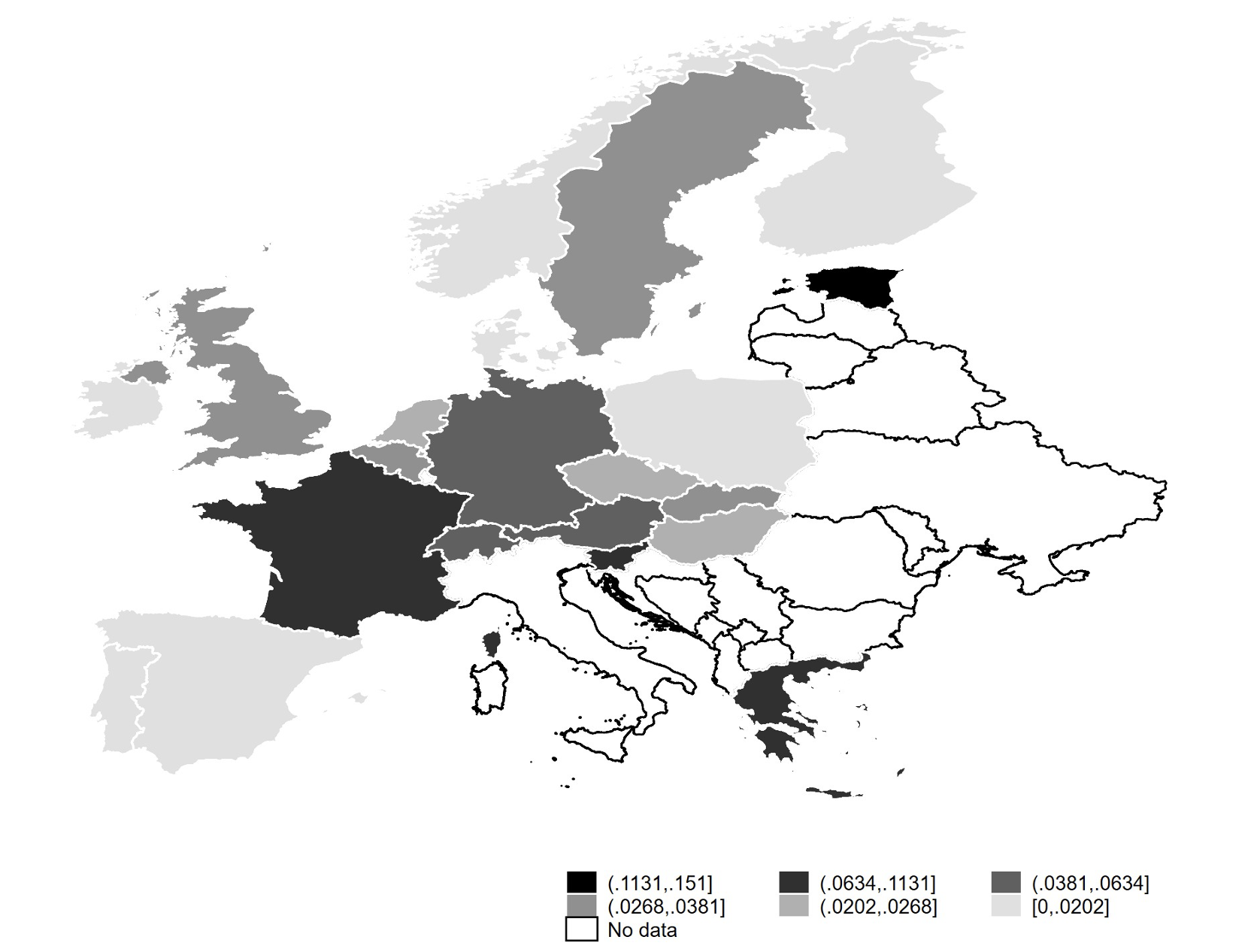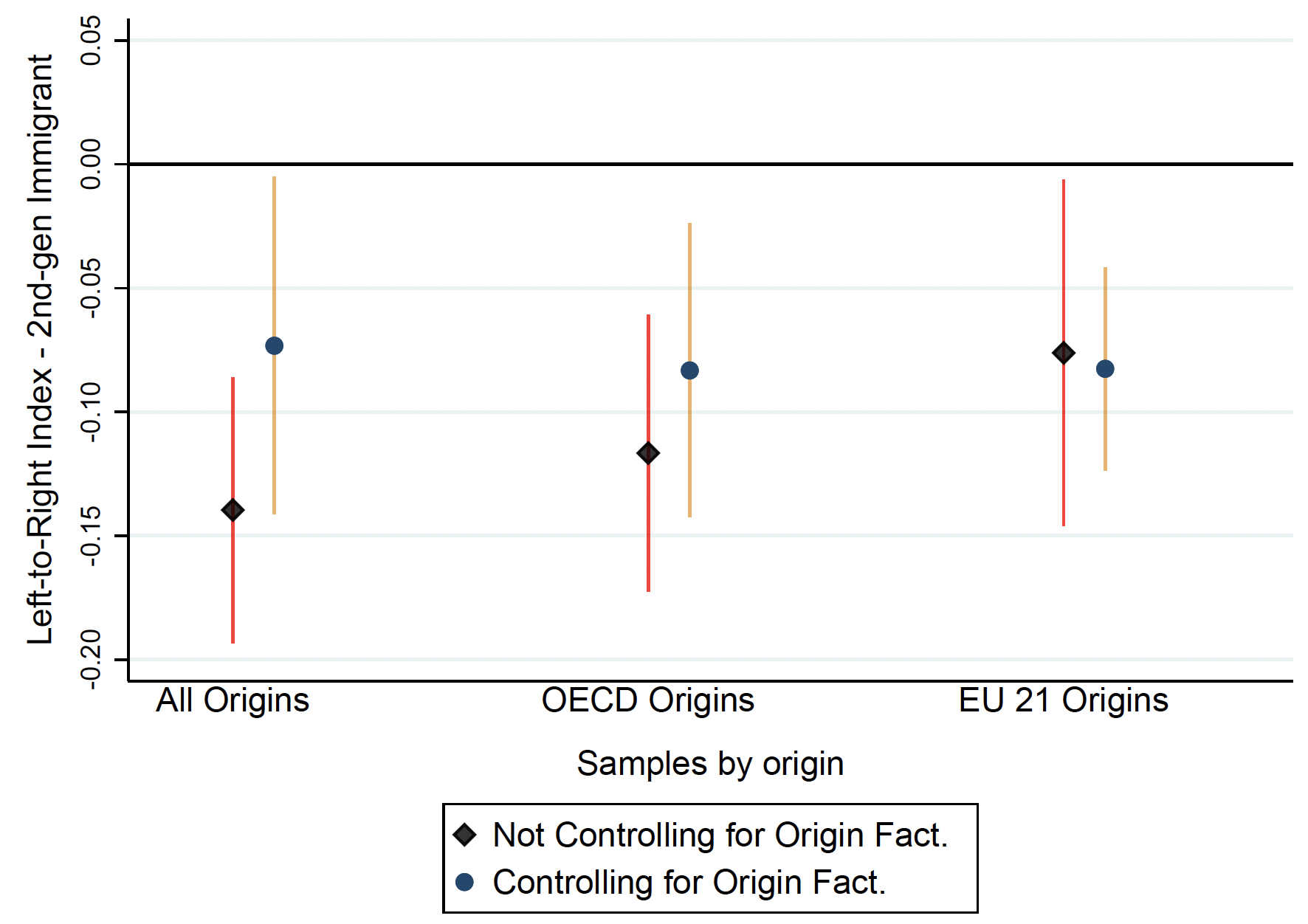The increase in international immigration towards rich countries over the last two decades has put the issue of immigration at the front and centre of many parties’ political agendas. Research shows that recent immigration flows have exacerbated natives’ concerns about cultural clashes, economic competition, and the fiscal costs of immigration – anxieties that contributed to the rise of right-wing parties with nationalist and anti-immigration agendas (Halla et al. 2015, Guriev and Papaioannou 2022). Not all immigration, however, pulls natives political reactions towards right-wing parties. Mayda et al. (2022) and Moriconi et al. (2022b) show that the effect of new inflows of immigrants on natives’ political preferences depend on immigrants’ characteristics, and especially on their education levels. Dustmann et al. (2018) show that native reaction depends on urban versus rural locations. Each of these effects are identified by looking at data from the last ten to 15 years.
Much less is known, however, about the possible political consequences of immigration over the longer term, and on the political preferences of immigrants themselves. By settling permanently in a country, immigrants can influence the long-run political landscape in ways distinct from the initial reaction of natives. First, by interacting over their lifetimes with natives, and sharing views partly rooted in the culture of their origin country, immigrants can influence natives’ preferences on important political topics. Giuliano and Tabellini (2020) show that in the long run, pro-redistribution preferences of European immigrants during the age of mass migration affected Americans living in areas highly exposed to them, who now hold stronger pro-redistribution political preferences as well. Additionally, immigrants and their offspring can directly affect electoral outcomes when they obtain the right to vote. This issue was an implicit concern of Éric Zemmour’s French presidential campaign in 2021 and was at the centre of a heated debate around citizenship rights during the Italian national election campaigns of 2022. However, we have limited evidence on the political preferences of immigrants, and most of it is focuses on the US (Giavazzi et al. 2014).
Our recent work (Moriconi et al. 2022a) explores this issue by studying the differences in political preferences between natives and second-generation immigrants across 22 European countries.
Relying on nine waves of the European Social Survey (ESS), we define as second-generation those immigrants born in the country where they reside whose fathers were born abroad (Fernandez and Fogli 2009). We use information on party preference in the previous national elections, which we match with measures of a party’s political stance in terms of a left-to-right index available from the Manifesto Project Database (MPD). Hence, our analysis measures how second-generation immigrants and natives voted in terms of this left-to-right political index, aggregating 92 national elections between 2001 and 2017.
We control for all observable socioeconomic characteristics that can influence political preferences – education, income, age, marriage, employment status – and we compare voting preferences of second-generation migrants and natives. If immigrants’ children are completely assimilated to the natives in terms of political preferences, we would observe no difference after controlling for those characteristics (Algan et al. 2010, Fouka et al. 2018, and Abramitzky et al. 2020 document a significant albeit incomplete degree of economic convergence for second-generation immigrants). On the other hand, systematic and significant differences in political stances would imply that immigrants’ offspring affect the long-run political landscape of a country. It would be important to understand the determinants of such differences and their potential implications for future elections. Second-generation immigrants are growing as percentage of the European population, and this group will become electorally relevant in a generation or two. Figure 1 shows the geographical distribution of second-generation immigrants. Estonia is the country with the highest share of second-generation immigrants, at 12% of the native population, due to the high number of Russian-born fathers. Countries characterised by a strong colonial background – like France, the UK, or Belgium – and more immigration in the 1980’s and 90’s are also characterised by a sizeable group of second-generation immigrants, between 5% and 7% of the native population.
Figure 1 Second-generation immigrants’ geographical distribution
Note: authors’ calculation on ESS data. Figure plots the average share of second-generation immigrants over the total population as of 2005.
Our main findings are presented in Figure 2, which shows the estimated difference in the left (negative values) to right (positive value) index of party voted for between second-generation immigrants and natives after controlling for all observable characteristics. In an index with an average of zero (perfect centrist party) and a standard deviation of one, the difference in political preferences between second generation immigrants and natives is about -0.1. Compared to natives, immigrants express stronger left-wing political preferences by voting, on average, for parties with a more left-wing political agenda. In the alternative estimates reported in Figure 2, we also control for the heterogeneity of one’s country of origin’s specific effects, to see if the left-wing preference is due to a specific set of countries of origin, and we progressively restrict the samples to include only European countries of origin. The estimated coefficients are always statistically significant, quantitatively large, and comparable to the estimated effect of other relevant individual predictors of voting behaviour (O’Rourke 2008, Cantoni and Pons 2022). Figure 3 shows the estimated native-immigrant difference compared to other estimated differences based on population characteristics. The left-wing preference of second-generation migrants relative to natives is comparable in size to the left-wing preference of people with secondary educations relative to primary educations, as well as to the left-wing preference of urban residents relative to rural.
Figure 2 Migrant to native difference in left-to-right voting
Note: authors’ estimates on ESS data, adapted from Moriconi et al. (2022a). Figure reports the regression-estimated second-generation migrants’ voting preferences compared to natives. Negative coefficients imply voting preferences towards left-leaning parties. The figure reports the results from the unrestricted (leftmost) sample in terms of second-generation migrants’ origins to the most restricted (rightmost), including only the sample of country of origin within the EU21. Black diamonds show the estimates without controlling for voters’ country of origin, while blue dots report estimates after controlling for voters’ country of origin (country of origin fixed-effects). The country of origin is determined by the birthplace of the father.
Figure 3 Migrant to native difference in left-to-right voting
(comparison with differences associated to other individual characteristics)
Note: authors’ calculations on ESS data, adapted from Moriconi et al. (2022a). Figure reports the estimated coefficients over the different individual characteristics, estimated on the most restrictive sample of EU 21 origins and controlling for country of origin characteristics.
In the second part of our paper, we examine the difference in preferences for specific policies. Relying on information provided by the ESS on individual attitudes and opinions of EU citizens, we show that second-generation immigrants have significantly different preferences than natives in a few areas: they are more tolerant towards different sexual preferences, they believe in the enriching role of diversity in the host society, they are in favour of stronger EU integration, and they support government intervention to reduce income inequalities. These are preferences usually associated with left-wing parties. At the same time, they are not more likely than natives to identify with a specific political ideology. This suggests that their left-wing preference is related to their specific policy-demand rather than an ideological identity. Focusing, then, on additional information provided by the MPD on party agendas, we find that the second-generation immigrants’ left-wing preference is not driven by immigration-specific issues: they do not vote for parties that promote less restrictive migration policies or more lax naturalisation laws. Additionally, we find that they are less prone to vote for parties with a populist agenda.
As pointed out by Portes and Rumbaut (2001), important factors that could explain the assimilation of immigrants’ children are the perceived attitudes of the host community and the experience of the immigrant family in the host country. We explore these hypotheses and find that second-generation migrants’ perceived discrimination (revealed by a survey question) or the language spoken at home (proxy for assimilation of the family) are not factors affecting their left-wing preferences. However, the father’s negative labour market experience in the host country plays a relevant role in shaping second-generation immigrants’ political preferences. If the father was ‘under-placed’ – i.e. employed in a job for which he had higher educational qualifications – the left-wing preference expressed by his child’s vote is stronger. Parents’ labour market experience could be a crucial factor in explaining second-generation assimilation and political views (Mariani and Mercier 2021).
Finally, our work explores whether current and future growth in the size of the second-generation migrant populations of Western Europe could play a significant role in shaping the left-to-right political balance. Using the estimated intensity of left-wing preferences among second-generation immigrants, and their observed and projected shares in the total population of each country, the simulation exercise shows that this effect by itself is likely to have only a limited impact on the political outcomes of most Western European countries.
Overall, our findings suggest that immigration in the European context may have a long-lasting effect on countries’ political landscapes through second-generation immigrants, as they have a stronger preference for left-wing parties and policies relative to natives. This effect is not explained by country-of-origin preferences, suggesting that there are some common features in being an immigrant’s son or daughter that systematically affects political preferences. Considering the growing relevance of such a population, particularly among young cohorts, EU politicians could soon target their specific political demands. In the area of politics, as in other areas, the long-run effects of immigration can be missed or misunderstood if we look only at immediate reactions and short-run responses.
References
Abramitzky, R, L Boustan and K Eriksson (2020), “Do immigrants assimilate more slowly today than in the past?”, American Economic Review: Insights 2(1): 125–41.
Algan, Y, C Dustmann, A Glitz and A Manning (2010), “The economic situation of first and second-generation immigrants in France, Germany and the United Kingdom”, The Economic Journal 120(542): F4–F30.
Cantoni, E and V Pons (2022), “Does context outweigh individual characteristics in driving voting behavior? Evidence from Relocations within the United States”, American Economic Review 112(4): 1226–72.
Dustmann, C, K Vasiljeva and A Piil Damm (2019), “Refugee Migration and Electoral Outcomes”, The Review of Economic Studies 86(5): 2035–2091.
Fernandez, R and A Fogli (2009), “Culture: An empirical investigation of beliefs, work, and fertility”, American Economic Journal: Macroeconomics 1(1): 146–77.
Giavazzi, F, I Petkov and F Schiantarelli (2014), “Culture: Persistence and evolution”, VoxEU.org, 08 June.
Giuliano, P and M Tabellini (2020), “The seeds of ideology: Historical immigration and political preferences in the US”, VoxEU.org, 10 June.
Guriev, S and E Papaioannou (2022), “The political economy of populism”, Journal of Economic Literature 60(3): 753–832.
Fouka, V, M Soumyajit and M Tabellini (2018), “The Great Migration and Immigrant assimilation”, VoxEU.org, 17 June.
Halla, M, A Wagner and J Zweimüller (2015), “Immigration and far-right voting: new evidence”, VoxEU.org, 29 November.
Mariani, F and M Mercier (2021), “Immigration and crime: The role of self-selection and institutions”, Journal of Economic Behavior and Organization 185: 538–564.
Mayda, A M, G Peri and W Steingress (2022), “The political impact of immigration: Evidence from the United States”, American Economic Journal: Applied Economics 14(1): 358–89.
Moriconi, S, G Peri and R Turati (2022a), “Are Immigrants more Left leaning than Natives?”, NBER Working Paper 30523.
Moriconi, S, G Peri and R Turati (2022b), “Skill of the immigrants and vote of the natives: Immigration and nationalism in European elections 2007–2016”, European Economic Review 141: 103986.
O'Rourke, K (2008), “The Irish ‘no’ and the rich-poor/urban-rural divide”, VoxEU.org, 14 June.
Portes, A and R G Rumbaut (2001), Legacies: The story of the immigrant second generation, University of California Press.







